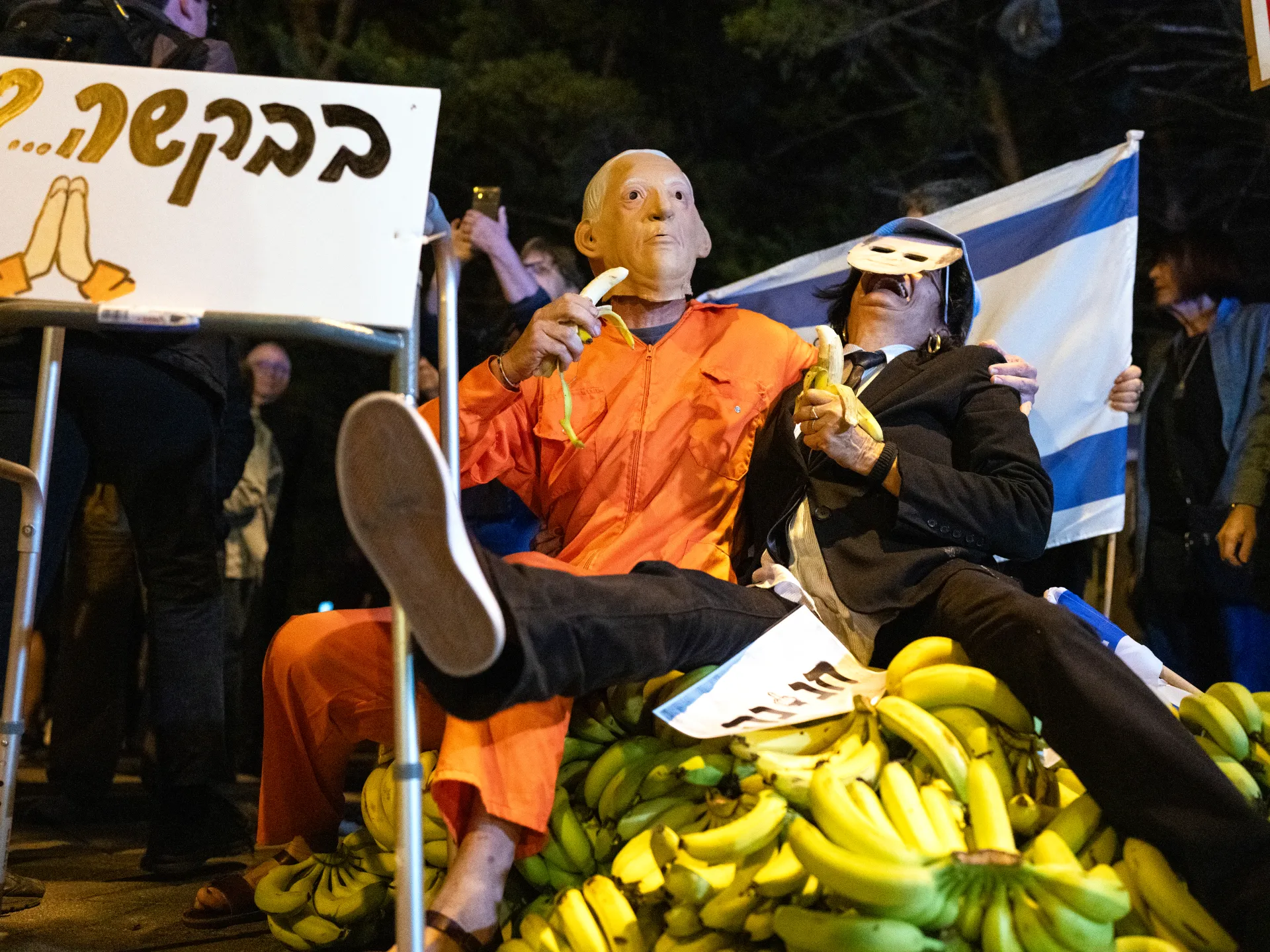Israelis protest in Tel Aviv after Netanyahu seeks pardon on fraud cases | Benjamin Netanyahu News
Angry crowds of Israelis have rallied outside President Isaac Herzog’s home in Tel Aviv, protesting against Prime Minister Benjamin Netanyahu’s petition for a full pardon from corruption charges.
The protest on Sunday night came hours after Netanyahu, 76, sought the presidential pardon in his long-running corruption trial, without admitting guilt or expressing remorse.
Recommended Stories
list of 4 itemsend of list
Opposition lawmakers, including Naama Lazimi, joined dozens of activists at the protest – held under the slogan “Pardon = Banana Republic” – outside Herzog’s private home, demanding he reject the request.
One protester dressed up as Netanyahu in an orange prison-style jumpsuit, while others stood behind a large pile of bananas and a sign that said “pardon” on it.
“He is asking that his trial will be completely cancelled without taking any responsibility, without paying the price for how he tore up this country,” said prominent antigovernment activist Shikma Bressler.
“People of Israel understand what is at stake, and it really is the future of our country,” she added.
Netanyahu, the country’s longest-serving prime minister, has been on trial for five years on three separate cases of corruption, including charges of bribery, fraud and breach of trust.
In one case, Netanyahu and his wife, Sara, are accused in one case of accepting more than $260,000 worth of luxury goods, such as cigars, jewellery and champagne, from billionaires in exchange for political favours. He is also accused of attempting to negotiate more favourable coverage from two Israeli media outlets in two other cases.
Netanyahu denies the charges, and his lawyers said in a 111-page letter to the president’s office that the prime minister still believes the legal proceedings would result in a complete acquittal.
In a brief video statement, Netanyahu said he wanted to see the process through, “but the security and political reality – the national interest – dictate otherwise”.
“The continuation of the trial is tearing us apart from within, arousing fierce divisions, intensifying rifts,” he added.
Herzog’s office confirmed it had received Netanyahu’s request.
“This is an extraordinary request, which carries with it significant implications. After receiving all of the relevant opinions, the president will responsibly and sincerely consider the request,” it said.
Beyond the domestic charges, Netanyahu is also wanted by The Hague-based International Criminal Court (ICC). In November 2024, the ICC issued arrest warrants for Netanyahu and former Minister of Defence Yoav Gallant on charges of war crimes and crimes against humanity in the genocidal war on Gaza.
Israel’s war on the Palestinian territory has killed more than 70,000 people, mostly women and children, and wounded nearly 171,000 others.
Netanyahu’s pardon request comes weeks after United States President Donald Trump publicly urged Israel to pardon Netanyahu, turning to Herzog during his speech to Israel’s parliament last month.
Earlier this month, Trump also sent a letter to Herzog, calling the corruption case a “political, unjustified prosecution”.
Pardons in Israel have typically been granted only after legal proceedings have concluded and the accused has been convicted. Netanyahu’s request triggered an immediate backlash.
Opposition leader Yair Lapid said Netanyahu should not be pardoned without admitting guilt, expressing remorse, and immediately retiring from political life.
Opposition politician Yair Golan, a former deputy chief of the military, called on the prime minister to resign, urging the president not to grant a pardon.
“Only the guilty seek pardon,” Golan said.
The Movement for Quality Government in Israel said that granting a pardon to a prime minister accused of serious offences of fraud and breach of trust would send a clear message that there are citizens who are above the law.
‘Liability’
Outside Herzog’s home, protester Ami Dror, 52, said the president’s job was to “protect Israeli democracy… and if you demolish law and order, this might be the end of Israeli democracy”.
Coalition allies, meanwhile, issued statements supporting Netanyahu’s request for a pardon, including National Security Minister Itamar Ben-Gvir and Finance Minister Bezalel Smotrich.
Smotrich said Netanyahu had “been persecuted for years by a corrupt judicial system that fabricated political cases against him”, while Defence Minister Israel Katz said a pardon would end the “deep rift that has accompanied Israeli society for nearly a decade”.
Al Jazeera’s senior political analyst Marwan Bishara, reporting from Doha, called Netanyahu a “liability for Israel”.
“Israel has been boasting for decades to be the one and only democracy in the Middle East. Yes, it is a procedural democracy for Jews in Israel, and even that has been diminishing slowly but surely under Netanyahu,” he said.
Bishara pointed to Netanyahu’s “crusade” against Israel’s judiciary, including the Supreme Court, before the war on Gaza, noting the moves had triggered widespread antigovernment protests in Israel.
“So, he has an issue with legality and institutions and liberal democracy. And internationally, he’s now been indicted by the International Criminal Court for war crimes, and he led Israel into a genocidal war, which is the subject of proceedings at the International Court of Justice,” Bishara said.
“The man is an outlaw. He is an international fugitive… Israel’s economy is not going to pick up as long as he’s prime minister. Israel’s society is not going to heal, and the war is not going to end as long as he’s prime minister,” the analyst added.
“All in all, he does not bode well for Israel because he’s hostage to his criminal past.”
